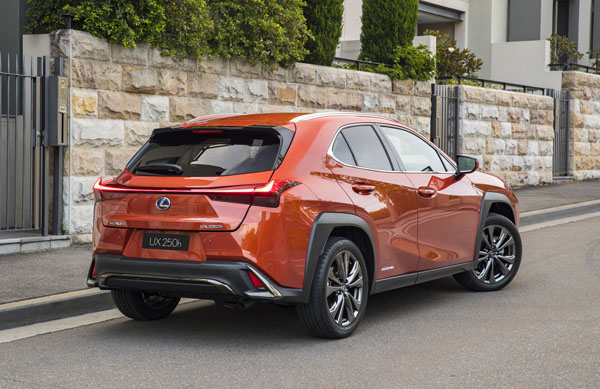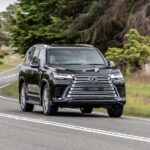
It’s been a couple of years since we last drove the Lexus UX, a compact SUV in name that
sits not much higher than the hatch it replaces.
It all looks and feels very familiar which suggests not much has changed in that time, but
let’s find out.
Hang on, that’s right – there’s now a fully-electric version (but it’s not the one we’re driving
here).
STYLING
Launched here in 2019, the front of the SUV is dominated by what Lexus calls its
prominent ‘spindle’ grille.
At the rear the tail lights are joined like Soobies of old, with a strip of 120 LEDs across the
back and there’s the obligatory grey plastic cladding to define its off-road status.
It would look a hell of a lot classier if it was painted.
Prices start from $44,445 for the UX 200, with a 2.0-litre, non-hybrid, two-wheel drive
Luxury grade.
The hybrid two-wheel drive starts from $52,025, all-wheel drive hybrid from $63,600 and
fully-electric model from $74,000, with a variety of enhancement packs available.
The small difference in price between some grades is a curious thing, particularly the gap
between F-Sport and Sport Luxury grades — at only $500.
Standard equipment includes faux leather, two-zone climate, power adjustable steering
column, leather accented steering wheel and shift lever, heated front seats with 10-way
driver and 8-way passenger power adjustment.
There are 17-inch alloys, smart start, LED head and tail lights, all-speed active cruise
control, automatic high beam, road sign assist, an auto-dimming rear view mirror, auto
lights and wipers, front and rear parking sensors.

The list continues with 7.0-inch driver information display, tyre pressure monitoring, a rear
spoiler and an alarm system.
Sports Luxury adds larger 18.0-inch alloys, leather accented upholstery, ventilation for
front seats, tri-beam LED headlights, power tailgate, adaptive high beam and wireless
phone charging.
INFOTAINMENT
Infotainment consists of a 10.3-inch infotainment screen, 8-speaker audio system, satellite
navigation, Bluetooth, AM, FM, DAB digital radio, Apple CarPlay and Android Auto and the
Lexus App Suite (as well as retaining a CD player).
The standard 8-speaker system has bamboo charcoal speaker diaphragms that reduce
mass and deliver natural-sounding voices and improved mid-range sound.
There is a centre-dash tweeter, 16cm subwoofer mounted in the luggage area and a
powerful amplifier.
Sports Luxury gets the you beaut Mark Levinson premium surround system, with a 13-
speaker array, low-distortion 668-watt Class D 8-channel amplifier, Quantum Logic
Surround Sound and ClariFi 2.0 technology – to deliver an immersive concert-like sound
experience.
There’s one 12-volt power outlet and dual rear-seat USB Type-C ports to recharge
smartphones or tablets.

ENGINES / TRANSMISSIONS
It is powered by a mild hybrid setup skewed more towards performance rather than
economy, combining a 2.0-litre petrol engine with an electric motor with a combined output
of 131kW.
The CVT style transmission offers six steps or gears and even in top gear has plenty of
poke – but in this model you don’t get gear change paddles.
Top speed of the UX is 177km/h and it does the dash from 0-100km/h in a reasonably
quick 8.7 seconds.
The electric motor is used to boost performance which is surprisingly good.
SAFETY
Lexus Safety Sense + is standard, including a pre-collision system with pedestrian
detection, all-speed active cruise control, lane trace assist, traffic sign recognition, auto
high beam, blind-spot monitor and rear cross-traffic alert.
Additional safety features include eight airbags, reversing camera, parking sensors, tyre
inflation warning, vehicle speed-limit warning and an anti-theft system.
Sports Luxury adds cornering lights, adaptive high beam and panoramic view monitor.
DRIVING
Lexus UX has smooth gear shifts and acceleration that is quite responsive. At a minimum
1635kg, we weren’t expecting big things from the performance department, but the hybrid
is surprisingly fun to drive.
In the all-wheel drive, the E-Four electric all-wheel drive system provides electric drive to
the rear axle, automatically providing extra grip in slippery conditions. It also compensates
for oversteer or understeer when pushing the car hard.
The system uses a separate, dedicated 5.3kW electric motor-generator integrated into the
rear differential.
Power distribution between the front and rear axles is automatically optimised by the
vehicle stability system when accelerating, cornering, or driving on slippery surfaces.
Maximum speed at which the car can operate in pure electric mode is 115 km/h, but you’ll
probably only reach this speed on a downhill run.
Drive modes include Normal, Eco, and Sport.
Normal mode provides an optimal balance between driving performance and fuel
efficiency.
Eco mode maximises fuel savings across all driving conditions by smoothing the throttle
response and by moderating air-conditioning operation.
Sport Mode delivers quicker throttle response and increased power steering feel.
The cabin offers comfy seats and a dash with a large infotainment screen, analogue clock,
and configurable instruments that change colour.
It is not a touchscreen and is controlled from a finger-operated touchpad located between
the seats. It works okay when you’re parked and sitting still, but is next to useless once the
car is underway.
Little knobs, like stubby handlebars protrude from the top of the dash, providing access to
different drive modes and the ability to turn off traction control – the latter not advised.
On the road the Lexus UX is quiet inside, at least on smooth bitumen.
It’s reasonably smooth and can be pushed hard without biting back.
Switching to manual mode and changing gears using the shift lever, produces the most
satisfying results. Shuffling between 3rd, 4th and 5th gears keeps the engine in the power
zone where you want it.
Handling is neutral, thanks to a low centre of gravity, with progressive breakaway,
controlled with some steering input, but some tyre squeal is evident during tight cornering.
The brakes are aggressive, at just about any speed.
Rear seat passengers get air vents, but the back is tight and lacks legroom, and the boot
is small and shallow.
Rated at 4.7L/100km, the 43-litre tank takes standard 91 unleaded. We clocked up 330km
at a rate of 6.0L/100km.
SUMMING UP
The Lexus UX ticks all the right boxes, but it’s a big ask for a smallish car. Since
introduction the company has cut prices in a bid to ignite sales, but a quick look at the
figures shows they are down 36 per cent year to date, with 370 sold this year compared to
580 for the same period in 2021.
That’s not sustainable.
RATINGS:
Looks: 6/10
Performance: 7/10
Safety: 8/10
Thirst: 8/10
Practicality: 7/10
Comfort: 7/10
Tech: 8/10
Value: 8/10
Overall: 7.25/10
AT A GLANCE
MODEL RANGE
UX 200 2WD Luxury, $44,445
UX 200 2WD Sports Luxury, $55,250
UX 200 2WD F Sport, $55,750
UX 250h 2WD Luxury, $52,025
UX 250h 2WD Sports Luxury, $59,100
UX 250h 2WD F Sport, $59,600
UX 250h AWD Sports Luxury, $63,600
UX 250h AWD F Sport, $64,100
UX 300e Luxury, $74,000
UX 300e Sports Luxury, $81,000
Note: These prices do not include government or dealer delivery charges. Contact your
local Lexus dealer for drive-away prices.
SPECIFICATIONS (UX 250h AWD Sports Luxury, small hybrid five-door SUV)
PERFORMANCE:
Capacity: 2.0-litres
Configuration: Mild hybrid, 4-cylinders in-line
Combined maximum power: 131kW @ 6000 rpm
Combined maximum torque: Not stated
Fuel Type: 91 RON petrol
Combined Cycle (ADR 81/01): 4.7 L/100km
CO2 Emissions: 107 g/km
DRIVELINE:
Electronic continuously variable transmission, all-wheel drive
DIMENSIONS, WEIGHT AND CAPACITIES:
Length: 4495 mm
Wheelbase: 2640 mm
Width: 1840 mm
Height: 1520 mm
Fuel Tank Capacity: 43 litres
Turning Circle: 10.4 metres
Kerb Mass: 1680 kg
BRAKES:
Front: 305 x 28 mm ventilated disc
Rear: 281 x 12 mm solid disc
STANDARD WARRANTY:
Four years/100,000km











